Wind Energy Potential in Pakistan: A Feasibility Study in Sindh Province
Abstract
1. Introduction
2. Wind Energy Conversion System (WECS)
2.1. Wind Turbine Generator (WTG) Technology
2.1.1. DC Generators
2.1.2. AC Synchronous Generators
2.1.3. AC Asynchronous Generators
3. Geographical Features and Generation Capacity of Pakistan
Wind Mapping of Pakistan
4. Results and Discussion
- (1)
- Zone 1—Karachi
- (2)
- Zone 2—Thatta
- (3)
- Zone 3—Badin
- (4)
- Zone 4—Jamshoro
5. Wind Energy Integration into the Power System
6. Conclusions
Author Contributions
Funding
Institutional Review Board Statement
Informed Consent Statement
Data Availability Statement
Conflicts of Interest
References
- Da Silveira Bezerra, P.B.; Callegari, C.L.; Ribas, A.; Lucena, A.F.P.; Portugal-Pereira, J.; Koberle, A.; Szklo, A.; Schaeffer, R. The Power of Light: Socio-Economic and Environmental Implications of a Rural Electrification Program in Brazil. Environ. Res. Lett. 2017, 12, 095004. [Google Scholar] [CrossRef]
- Martins, F.; Felgueiras, C.; Smitkova, M.; Caetano, N. Analysis of Fossil Fuel Energy Consumption and Environmental Impacts in European Countries. Energies 2019, 12, 964. [Google Scholar] [CrossRef]
- Asghar, R.; Rehman, F.; Ullah, Z.; Qamar, A.; Ullah, K.; Iqbal, K.; Aman, A.; Nawaz, A.A. Electric Vehicles and Key Adaptation Challenges and Prospects in Pakistan: A Comprehensive Review. J. Clean. Prod. 2021, 278, 123375. [Google Scholar] [CrossRef]
- Ullah, Z.; Asghar, R.; Khan, I.; Ullah, K.; Waseem, A.; Wahab, F.; Haider, A.; Ali, S.M.; Jan, K.U. Renewable Energy Resources Penetration within Smart Grid: An Overview. In Proceedings of the 2020 International Conference on Electrical, Communication, and Computer Engineering (ICECCE), Istanbul, Turkey, 12–13 June 2020. [Google Scholar] [CrossRef]
- Dinç, D.T.; Akdoğan, E.C. Renewable Energy Production, Energy Consumption and Sustainable Economic Growth in Turkey: A VECM Approach. Sustainability 2019, 11, 1273. [Google Scholar] [CrossRef]
- Ahmadi, A.; Tiruta-Barna, L.; Benetto, E.; Capitanescu, F.; Marvuglia, A. On the Importance of Integrating Alternative Renewable Energy Resources and Their Life Cycle Networks in the Eco-Design of Conventional Drinking Water Plants. J. Clean. Prod. 2016, 135, 872–883. [Google Scholar] [CrossRef]
- Asghar, R.; Rehman, F.; Ullah, Z.; Aman, A.; Iqbal, K.; Nawaz, A.A. Modified Switch Type Fault Current Limiter for Low-Voltage Ride-through Enhancement and Reactive Power Support of DFIG-WT under Grid Faults. IET Renew. Power Gener. 2020, 14, 1481–1490. [Google Scholar] [CrossRef]
- Mirza, I.A.; Khali, M.S. Renewable Energy in Pakistan: Opportunities and Challenges. Sci. Vis. 2011, 16, 13–20. [Google Scholar]
- Hulio, Z.H.; Jiang, W.; Chandio, G.S. Power Policies, Challenges, and Recommendations of Renewable Resource Assessment in Pakistan. Energy Explor. Exploit. 2022, 40, 947–976. [Google Scholar] [CrossRef]
- Ayaz Akhbar Energy Crisis: Markets, Shopping Malls to Close by 9pm in Islamabad. Available online: https://www.geo.tv/latest/423187-electricity-crisis-markets-shopping-malls-to-close-by-9pm-in-islamabad (accessed on 28 July 2022).
- The Straits Times Facing “Severe” Energy Crisis, Pakistan Reverts to Five-Day Work Week. Available online: https://www.straitstimes.com/asia/south-asia/facing-severe-energy-crisis-pakistan-reverts-to-five-day-work-week (accessed on 28 July 2022).
- Azeem, K.; Nadeem, W.; Zia, A.; Shehzad, S.; Anwar, Z. Impact of CNG Crisis on Student’s Academic Life. J. Educ. Pract. 2017, 8, 81–90. [Google Scholar]
- Hydrocarbon Development Institute of Pakistan Pakistan Energy Yearbook. 2020. Available online: https://www.hdip.com.pk/energy-yearbook.php (accessed on 28 July 2022).
- Mir, K.A.; Purohit, P.; Mehmood, S. Sectoral Assessment of Greenhouse Gas Emissions in Pakistan. Environ. Sci. Pollut. Res. Int. 2017, 24, 27345–27355. [Google Scholar] [CrossRef]
- IPCC. The IPCC’s Fifth Assessment Report: What’s in it for South Asia? Intergov. Panel Clim. Chang. 2014, 70–79. Available online: http://cdkn.org/wp-content/uploads/2014/04/J1731_CDKN_FifthAssesmentReport_WEB.pdf. (accessed on 28 July 2022).
- Mustafa, Z. Climate Change and Its Impact with Special Focus in Pakistan. Pakistan Eng. Congr. Symp. 2011, 33, 100–116. [Google Scholar]
- Syed, A.; Raza, T.; Bhatti, T.T.; Eash, N.S. Climate Impacts on the Agricultural Sector of Pakistan: Risks and Solutions. Environ. Chall. 2022, 6, 100433. [Google Scholar] [CrossRef]
- Shaheen, N.; Jahandad, A.; Goheer, M.A.; Ahmad, Q.A. Future Changes in Growing Degree Days of Wheat Crop in Pakistan as Simulated in CORDEX South Asia Experiments. APN Sci. Bull. 2020, 10, 82–89. [Google Scholar] [CrossRef]
- Hannah Ritchie; Max Roser Pakistan: CO2 Country Profile-Our World in Data. Available online: https://ourworldindata.org/co2/country/pakistan (accessed on 31 October 2022).
- Chaudhry, Q.U.Z. Climate Change Profile of Pakistan Climate Change Profi Le of Pakistan. Asian Dev. Bank 2017, 30–35. [Google Scholar] [CrossRef]
- Mirza, I.A.; Khan, N.A.; Memon, N. Development of Benchmark Wind Speed for Gharo and Jhimpir, Pakistan. Renew. Energy 2010, 35, 576–582. [Google Scholar] [CrossRef]
- Baloch, M.H.; Kaloi, G.S.; Memon, Z.A. Current Scenario of the Wind Energy in Pakistan Challenges and Future Perspectives: A Case Study. Energy Rep. 2016, 2, 201–210. [Google Scholar] [CrossRef]
- Hulio, Z.H.; Jiang, W.; Rehman, S. Technical and Economic Assessment of Wind Power Potential of Nooriabad, Pakistan. Energy Sustain. Soc. 2017, 7, 35. [Google Scholar] [CrossRef]
- Mushahid Hussain Pakistan’s Battle Against Climate Change. Available online: https://www.ipsnews.net/2019/04/pakistans-battle-climate-change/ (accessed on 28 July 2022).
- SAARC Energy Centre. Deployment of Electric Road Mass Transportation in South Asia; SAARC Energy Centre: Islamabad, Pakistan, 2017. [Google Scholar]
- Shoaib, M.; Siddiqui, I.; Rehman, S.; Khan, S.; Alhems, L.M. Assessment of Wind Energy Potential Using Wind Energy Conversion System. J. Clean. Prod. 2019, 216, 346–360. [Google Scholar] [CrossRef]
- Majout, B.; El Alami, H.; Salime, H.; Zine Laabidine, N.; El Mourabit, Y.; Motahhir, S.; Bouderbala, M.; Karim, M.; Bossoufi, B. A Review on Popular Control Applications in Wind Energy Conversion System Based on Permanent Magnet Generator PMSG. Energies 2022, 15, 6238. [Google Scholar] [CrossRef]
- Tiwari, R.; Babu, N.R. Recent Developments of Control Strategies for Wind Energy Conversion System. Renew. Sustain. Energy Rev. 2016, 66, 268–285. [Google Scholar] [CrossRef]
- Kala, H.; Sandhu, K.S. Effect of Change in Power Coefficient on the Performance of Wind Turbines with Different Dimensions. In Proceedings of the 2016 International Conference on Microelectronics, Computing and Communications (MicroCom), Durgapur, India, 23–25 January 2016. [Google Scholar] [CrossRef]
- Majout, B.; Bossoufi, B.; Bouderbala, M.; Masud, M.; Al-Amri, J.F.; Taoussi, M.; El Mahfoud, M.; Motahhir, S.; Karim, M. Improvement of PMSG-Based Wind Energy Conversion System Using Developed Sliding Mode Control. Energies 2022, 15, 1625. [Google Scholar] [CrossRef]
- De Lellis, M.; Reginatto, R.; Saraiva, R.; Trofino, A. The Betz Limit Applied to Airborne Wind Energy. Renew. Energy 2018, 127, 32–40. [Google Scholar] [CrossRef]
- Baloch, M.H.; Abro, S.A.; Kaloi, G.S.; Mirjat, N.H.; Tahir, S.; Nadeem, M.H.; Gul, M.; Memon, Z.A.; Kumar, M. A Research on Electricity Generation from Wind Corridors of Pakistan (Two Provinces): A Technical Proposal for Remote Zones. Sustainability 2017, 9, 1611. [Google Scholar] [CrossRef]
- Daoudi, M.; Abdelaziz, A.S.M.; Mohammed, E.; Elmostapha, E. Analysis of Wind Speed Data and Wind Energy Potential Using Weibull Distribution in Zagora, Morocco. Int. J. Renew. Energy Dev. 2019, 8, 267–273. [Google Scholar] [CrossRef]
- Cao, W.; Xie, Y.; Tan, Z. Wind Turbine Generator Technologies. Adv. Wind Power 2012, 1, 177–204. [Google Scholar] [CrossRef]
- Chaudhuri, A.; Datta, R.; Kumar, M.P.; Davim, J.P.; Pramanik, S. Energy Conversion Strategies for Wind Energy System: Electrical, Mechanical and Material Aspects. Materials 2022, 15, 1232. [Google Scholar] [CrossRef]
- Lebsir, A.; Bin Tunisi, A.; Mangel, H.; Bin Buzayd, M.E.H. Electric Generators Fitted to Wind Turbine Systems: An Up-to-Date Comparative Study. J. Electr. Syst. 2015, 11, 281–295. [Google Scholar]
- Manwell, J.F.; Mcgowan, J.G.; Rogers, A.L. Wind Energy Explain: Theory, Design and Application, 2nd ed.; John Wiley & Sons Ltd: Chichester, UK, 2009; pp. 23–87. ISBN 978-1-119-99436-7. [Google Scholar]
- Alternative Energy Permanent Magnet DC Generator for Wind Turbine Machines. Available online: https://www.alternative-energy-tutorials.com/wind-energy/pmdc-generator.html (accessed on 29 July 2022).
- Huanga, D.; Fan, S.; Fan, B. Virtual DC Generator Control Strategy for Load DC-DC Converter. In Proceedings of the 2015 International Symposium on Computers & Informatics, Beijing, China, 17–18 January 2015; Volume 13, pp. 1359–1368. [Google Scholar] [CrossRef]
- Zhi, N.; Ding, Y.; Du, L. Virtual DC Generator Control Strategy Based on Differential Compensation. In Proceedings of the 2019 IEEE Energy Conversion Congress and Exposition (ECCE), Baltimore, MD, USA, 29 September–3 October 2019; pp. 1454–1458. [Google Scholar] [CrossRef]
- Kavya, P.; Bharathi, A.V.; Apparao, A. Investigation on Usage of Brush Less DC Generator in Wind Farm Application. Int. J. Pure Appl. Math. 2017, 115, 513–517. [Google Scholar]
- Ruviaro, M.; Rüncos, F.; Sadowski, N.; Borges, I.M. Analysis and Test Results of a Brushless Doubly Fed Induction Machine with Rotary Transformer. IEEE Trans. Ind. Electron. 2012, 59, 2670–2677. [Google Scholar] [CrossRef]
- Yassin, H.M.; Abdel-Wahab, R.R.; Hanafy, H.H. Active and Reactive Power Control for Dual Excited Synchronous Generator in Wind Applications. IEEE Access 2022, 10, 29172–29182. [Google Scholar] [CrossRef]
- Goudarzi, N.; Zhu, W.D. A Review on the Development of Wind Turbine Generators across the World. Int. J. Dyn. Control 2013, 1, 192–202. [Google Scholar] [CrossRef]
- De Freitas, T.R.S.; Menegáz, P.J.M.; Simonetti, D.S.L. Rectifier Topologies for Permanent Magnet Synchronous Generator on Wind Energy Conversion Systems: A Review. Renew. Sustain. Energy Rev. 2016, 54, 1334–1344. [Google Scholar] [CrossRef]
- Potgieter, J.H.J.; Kamper, M.J. Design of New Concept Direct Grid-Connected Slip-Synchronous Permanent-Magnet Wind Generator. IEEE Trans. Ind. Appl. 2012, 48, 913–922. [Google Scholar] [CrossRef]
- Kim, Y.S.; Chung, I.Y.; Moon, S. Il Tuning of the PI Controller Parameters of a PMSG Wind Turbine to Improve Control Performance under Various Wind Speeds. Energies 2015, 8, 1406–1425. [Google Scholar] [CrossRef]
- Yang, B.; Shu, H.; Qiu, D.; Zhu, D. Optimal Passive PID Controller of PMSG for Maximum Power Point Tracking via Interactive Teaching-Learning Optimizer. In Proceedings of the 2018 37th Chinese Control Conference (CCC), Wuhan, China, 25–27 July 2018; pp. 7644–7649. [Google Scholar] [CrossRef]
- Youssef, A.R.; Mohamed, E.E.M.; Ali, A.I.M. Model Predictive Control for Grid-Tie Wind-Energy Conversion System Based PMSG. In Proceedings of the 2018 International Conference on Innovative Trends in Computer Engineering (ITCE), Aswan, Egypt, 19–21 February 2018; pp. 467–472. [Google Scholar] [CrossRef]
- Bakbak, A.; Canseven, H.T.; Altintas, M.; Ayaz, M.; Mese, E. Maximizing Energy Extraction from Direct Grid Coupled Permanent Magnet Synchronous Generators. In Proceedings of the 2021 IEEE Applied Power Electronics Conference and Exposition (APEC), Phoenix, AZ, USA, 14–17 June 2021; pp. 981–988. [Google Scholar] [CrossRef]
- Rasool, E.; Liaquat, M.; Bhatti, A.I.; Mehmood, A. Cooperative Adaptive Cruise Control with Fuel Efficiency Using PMP Technique. In Proceedings of the 2019 5th International Conference on Control, Automation and Robotics (ICCAR), Beijing, China, 19–22 April 2019; pp. 396–400. [Google Scholar] [CrossRef]
- Terao, Y.; Sekino, M.; Ohsaki, H. Electromagnetic Design of 10 MW Class Fully Superconducting Wind Turbine Generators. IEEE Trans. Appl. Supercond. 2012, 22, 5201904. [Google Scholar] [CrossRef]
- Asghar, R. Fault Current Limiters Types, Operations and Its Limitations. Int. J. Sci. Eng. Res. 2018, 9, 1020–1027. [Google Scholar]
- Zou, Y. Induction Generator in Wind Power Systems. Induction Mot.-Appl. Control Fault Diagn. 2015, 4–35. [Google Scholar] [CrossRef]
- Chen, H.; Zuo, Y.; Chau, K.T.; Zhao, W.; Lee, C.H.T. Modern Electric Machines and Drives for Wind Power Generation: A Review of Opportunities and Challenges. IET Renew. Power Gener. 2021, 15, 1864–1887. [Google Scholar] [CrossRef]
- Saini, S. Review of Doubly Fed Induction Generator Used in Wind Power Generation. Int. J. Environ. Sci. Dev. Monit. 2013, 4, 53–56. [Google Scholar]
- Mehdipour, C.; Hajizadeh, A.; Mehdipour, I. Dynamic Modeling and Control of DFIG-Based Wind Turbines under Balanced Network Conditions. Int. J. Electr. Power Energy Syst. 2016, 83, 560–569. [Google Scholar] [CrossRef]
- Liu, S.; Han, Y.; Du, C.; Li, S.; Zhang, H. Fuzzy PI Control for Grid-Side Converter of DFIG-Based Wind Turbine System. In Proceedings of the 2021 40th Chinese Control Conference (CCC), Shanghai, China, 26–28 July 2021; pp. 5788–5793. [Google Scholar] [CrossRef]
- Mensou, S.; Essadki, A.; Minka, I.; Nasser, T.; Idrissi, B.B. Backstepping Controller for a Variable Wind Speed Energy Conversion System Based on a DFIG. In Proceedings of the 2017 International Renewable and Sustainable Energy Conference (IRSEC), Tangier, Morocco, 4–7 December 2017. [Google Scholar] [CrossRef]
- Asghar, R.; Ali, A.; Rehman, F.; Ullah, R.; Ullah, K.; Ullah, Z.; Sarwar, M.A.; Khan, B. Load Frequency Control for EVs Based Smart Grid System Using PID and MPC. In Proceedings of the 2020 3rd International Conference on Computing, Mathematics and Engineering Technologies (iCoMET), Sukkur, Pakistan, 29–30 January 2020. [Google Scholar] [CrossRef]
- Khan, I.; Zeb, K.; Uddin, W.; Ishfaq, M.; Ul Islam, S.; Jan, K.U. Robust Control Design for DFIG Based Wind Turbine under Voltage Sags. In Proceedings of the 2020 3rd International Conference on Computing, Mathematics and Engineering Technologies (iCoMET), Sukkur, Pakistan, 29–30 January 2020. [Google Scholar] [CrossRef]
- Wikipedia Pakistan-Wikipedia. Available online: https://en.wikipedia.org/wiki/Pakistan (accessed on 31 July 2022).
- World Bank Exports of Goods and Services (Current US$)|Data. Available online: https://data.worldbank.org/indicator/NE.EXP.GNFS.CD?most_recent_value_desc=true (accessed on 31 July 2022).
- Manaky Seasons in Pakistan|Climate Change in Pakistan. Available online: https://manaky.com/almanak/seasons-in-pakistan (accessed on 24 May 2022).
- Raheem, A.; Abbasi, S.A.; Memon, A.; Samo, S.R.; Taufiq-Yap, Y.H.; Danquah, M.K.; Harun, R. Renewable Energy Deployment to Combat Energy Crisis in Pakistan. Energy. Sustain. Soc. 2016, 6, 16. [Google Scholar] [CrossRef]
- Luo, B.; Khan, A.A.; Ali, M.A.S.; Yu, J. An Evaluation of Influencing Factors and Public Attitudes for the Adoption of Biogas System in Rural Communities to Overcome Energy Crisis: A Case Study of Pakistan. Sci. Total Environ. 2021, 778, 146208. [Google Scholar] [CrossRef] [PubMed]
- Raza, M.A.; Khatri, K.L.; Ul Haque, M.I.; Shahid, M.; Rafique, K.; Waseer, T.A. Holistic and Scientific Approach to the Development of Sustainable Energy Policy Framework for Energy Security in Pakistan. Energy Rep. 2022, 8, 4282–4302. [Google Scholar] [CrossRef]
- NEPRA State of Industry Report 2020. Stat. Data About Energy Electr. Sect. 2021, 15, 80–97.
- Israr Khan Circular Debt at Rs2.467tr Threatens Power Sector Sustainability. Available online: https://www.thenews.com.pk/print/964747-circular-debt-at-rs2-467tr-threatens-power-sector-sustainability (accessed on 31 July 2022).
- Asian Development Bank. Proposed Programmatic Approach and Policy-Based Loan for Subprogram 2 Islamic Republic of Pakistan: Energy Sector Reforms and Financial Sustainability; 2021; pp. 1–7. Available online: https://www.adb.org/sites/default/files/project-documents/53165/53165-002-rrp-en.pdf (accessed on 22 November 2021).
- AEDB. Alternative and Renewable Energy Policy 2019; AEDB: Islamabad, Pakistan, 2021. [Google Scholar]
- The Express Tribune Construction of 10 Dams Will Ensure Food Security in Country: PM. Available online: https://tribune.com.pk/story/2300648/construction-of-10-dams-will-ensure-food-security-in-country-pm (accessed on 31 July 2022).
- GOP. Community-Based Renewable Energy Development in the Northern Areas and Chitral (NAC), Pakistan; GOP: Islamabad, Pakistan, 2019. [Google Scholar]
- Heneghan, B.; Boyne, K. Life-Cycle of an Onshore Wind Farm. Irsih Wind Energy Association (IWEA). 2019, 1–20. Available online: https://windenergyireland.com/images/files/iwea-onshore-wind-farm-report.pdf (accessed on 1 May 2019).
- IRENA Renewable Power Generation Costs in 2020. Available online: https://irena.org/publications/2021/Jun/Renewable-Power-Costs-in-2020 (accessed on 1 August 2022).
- Wikipedia Electricity Sector in Pakistan. Available online: https://en.wikipedia.org/wiki/Electricity_sector_in_Pakistan#cite_note-8 (accessed on 1 August 2022).
- Haris, Z.; Eric, Y. Fuel Shortages Hit Nearly a Quarter of Pakistan’s Operational Power Plants. Available online: https://www.spglobal.com/commodityinsights/en/market-insights/latest-news/energy-transition/072022-fuel-shortages-hit-nearly-a-quarter-of-pakistans-operational-power-plants (accessed on 1 August 2022).
- Manoj, V.; Swathi, A.; Rao, V.T. A PROMETHEE Based Multi Criteria Decision Making Analysis for Selection of Optimum Site Location for Wind Energy Project. IOP Conf. Ser. Mater. Sci. Eng. 2021, 1033, 012035. [Google Scholar] [CrossRef]
- Tabassum, Z.; Shastry, C.B.S. Renewable Energy Generation-Solar and Wind, Challenges and Policies Adopted in Karnataka, India. In Proceedings of the 2021 Fourth International Conference on Microelectronics, Signals & Systems (ICMSS), Kollam, India, 18–19 November 2021. [Google Scholar] [CrossRef]
- Sumair, M.; Aized, T.; Gardezi, S.A.R.; Bhutta, M.M.A.; Rehman, S.M.S.; ur Rehman, S.U. Comparison of Three Probability Distributions and Techno-Economic Analysis of Wind Energy Production along the Coastal Belt of Pakistan. Energy Explor. Exploit. 2020, 39, 2191–2213. [Google Scholar] [CrossRef]
- Harijan, K.; Uqaili, M.A.; Memon, M.; Mirza, U.K. Forecasting the Diffusion of Wind Power in Pakistan. Energy 2011, 36, 6068–6073. [Google Scholar] [CrossRef]
- Habib, S.; Muhammad Javed Iqbal, K.; Amir, S.; Naseer, H.M.; Akhtar, N.; Ur Rehman, W.; Irfan Khan, M. Renewable Energy Potential in Pakistan and Barriers to Its Development for Overcoming Power Crisis. Soc. Bus. Manag. 2021, 27, 6836–6846. [Google Scholar] [CrossRef]
- Elliott, D. South Asia Regional Initiative for Energy Cooperation and development (SARI-Energy): Wind Resource Assessment and Mapping for Afghanistan and Pakistan; National Renewable Energy Laboratory: Golden, CO, USA; Available online: https://nawabi.de/power/wind/afgpak_wind_nrel.pdf (accessed on 21 May 2007).
- Shami, S.H.; Ahmad, J.; Zafar, R.; Haris, M.; Bashir, S. Evaluating Wind Energy Potential in Pakistan’s Three Provinces, with Proposal for Integration into National Power Grid. Renew. Sustain. Energy Rev. 2016, 53, 408–421. [Google Scholar] [CrossRef]
- RajRAS. Power Resources of Rajasthan. Available online: https://www.rajras.in/rajasthan/economy/infrastructure/power/ (accessed on 1 August 2022).
- Wind Power Profile of Rajasthan; Jaipur, India, 2019. Available online: https://www.indianwindpower.com/pdf/Rajasthan-State-Wind-Power-Profile.pdf (accessed on 30 June 2019).

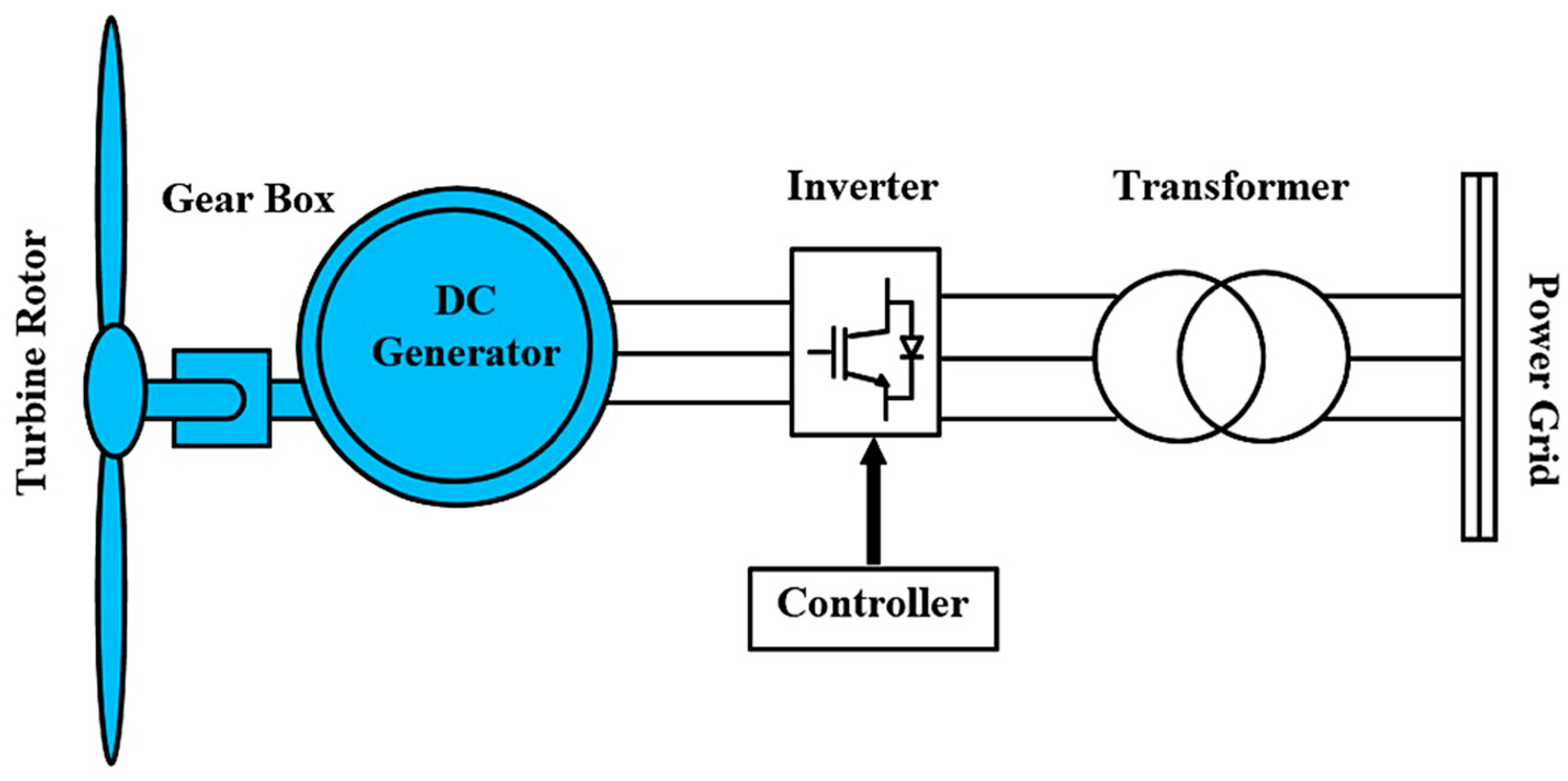
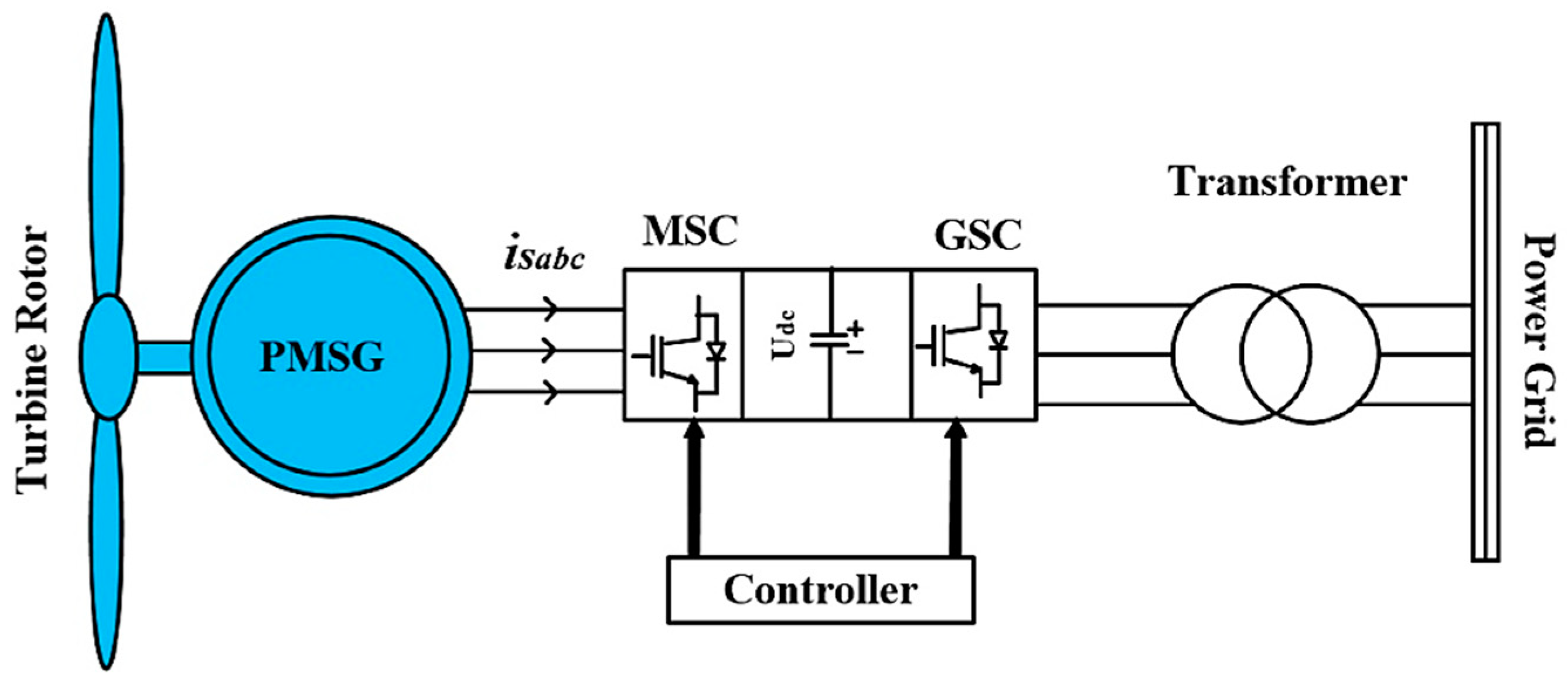

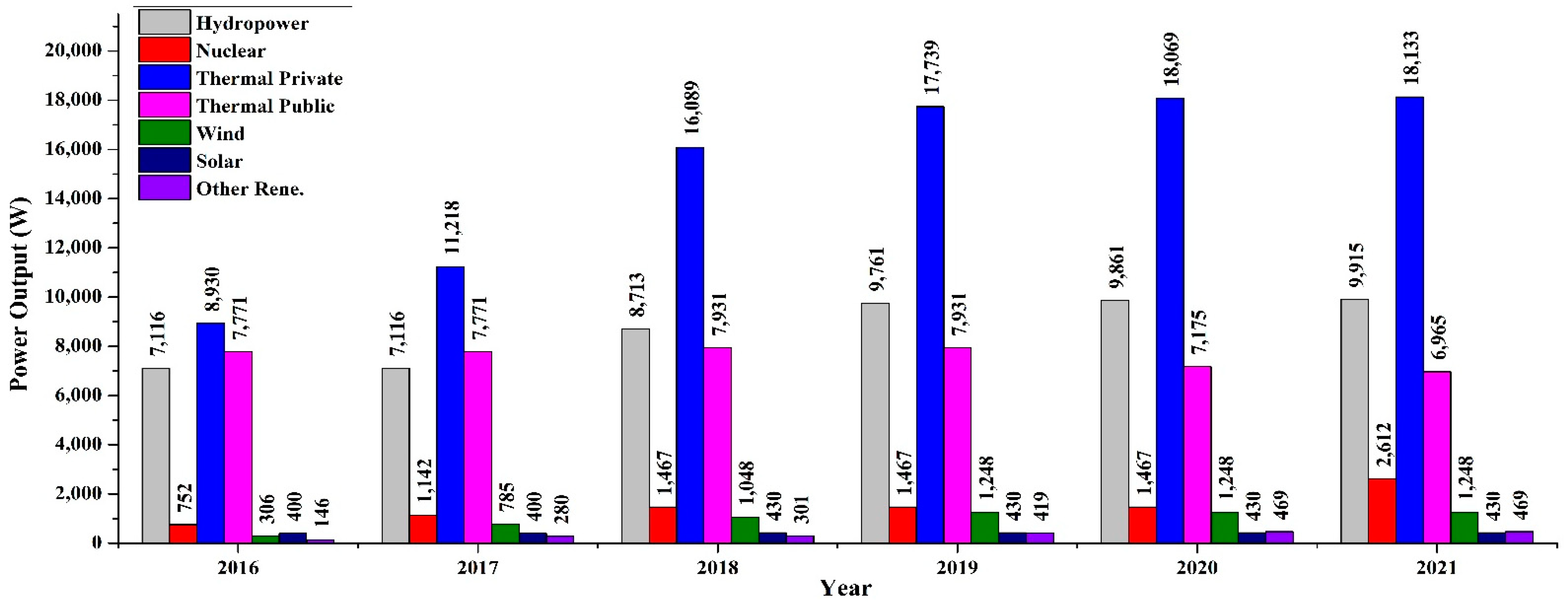
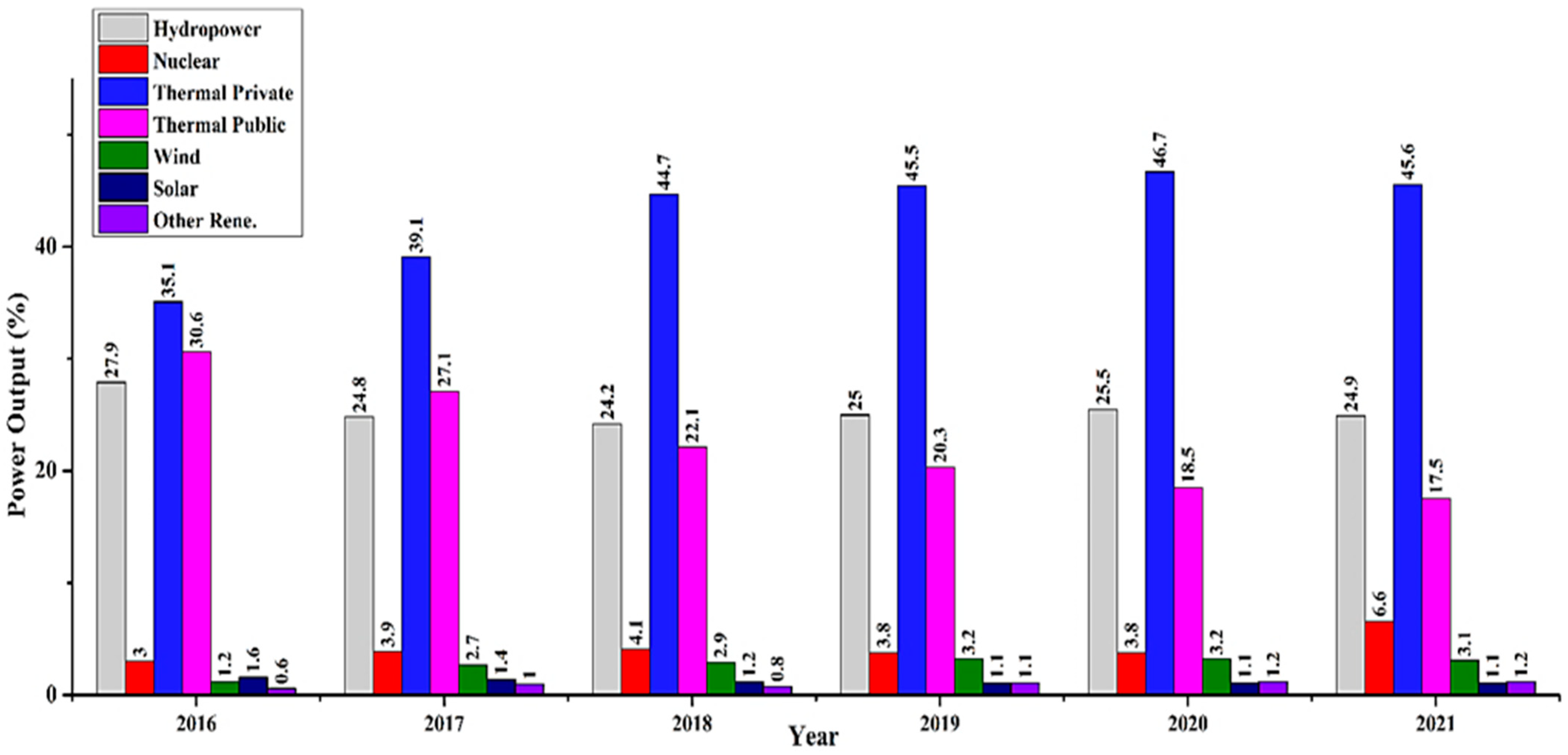
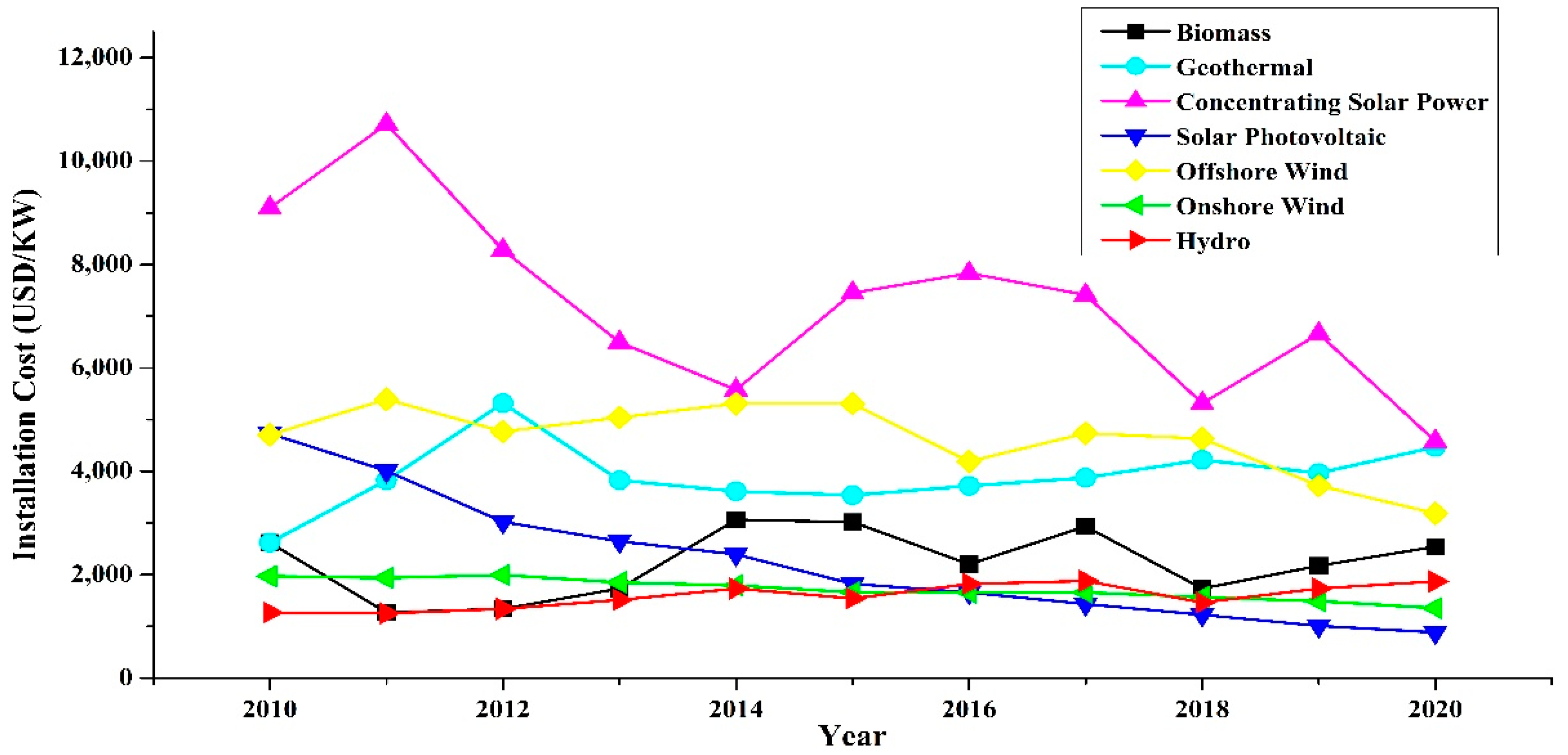
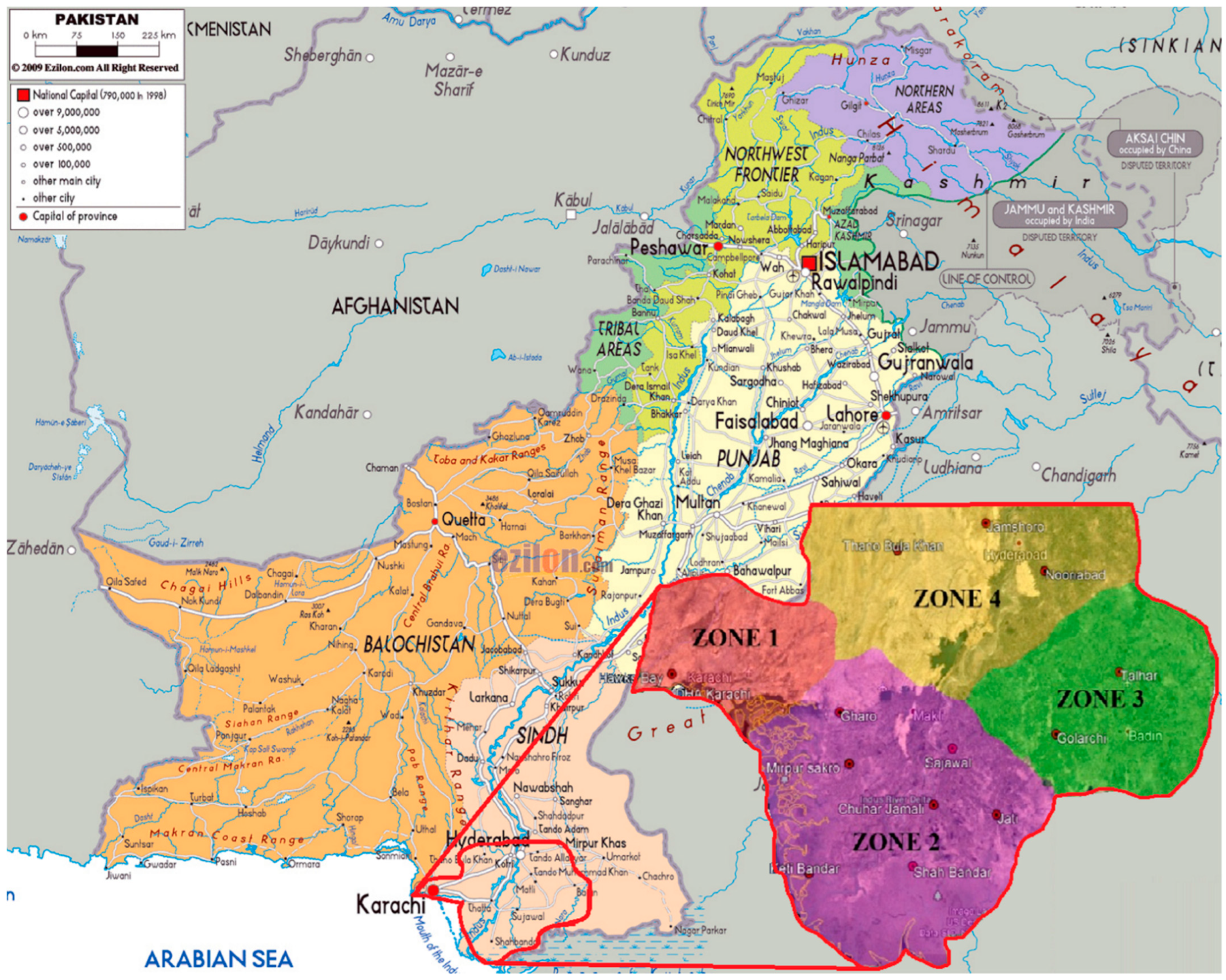
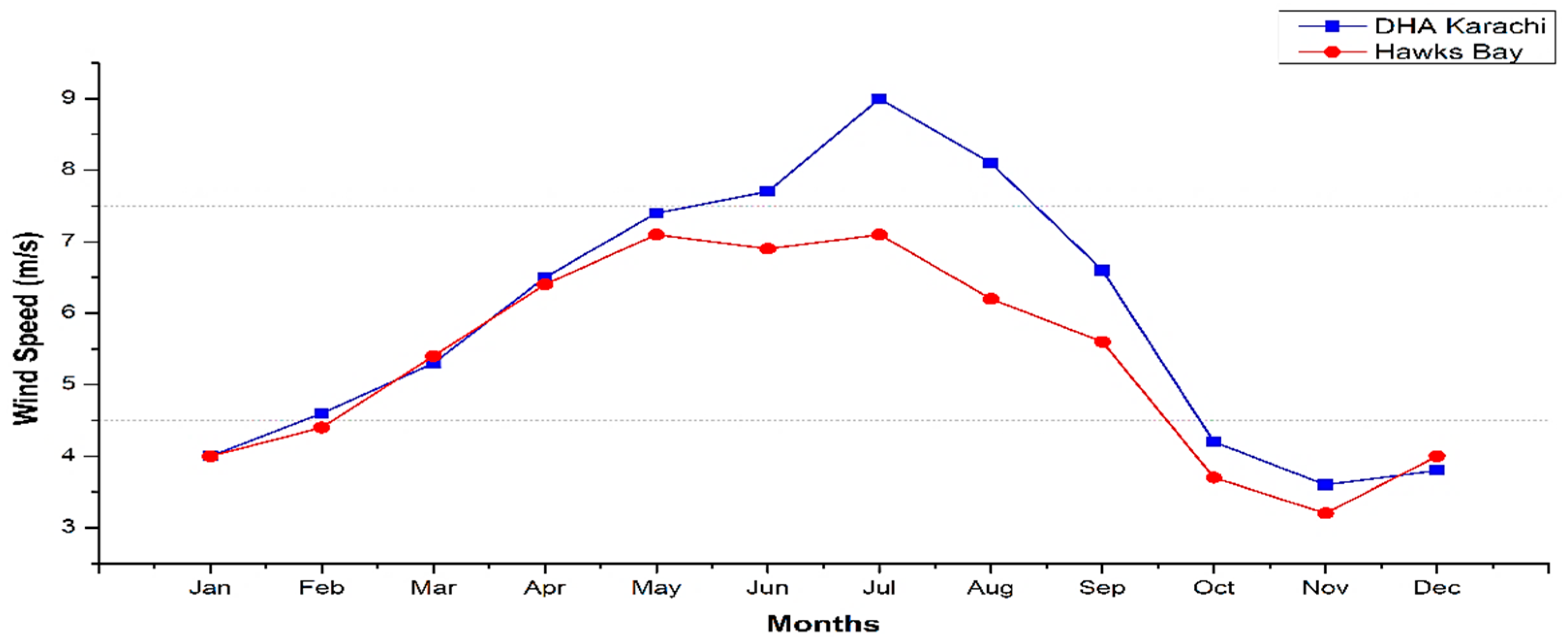
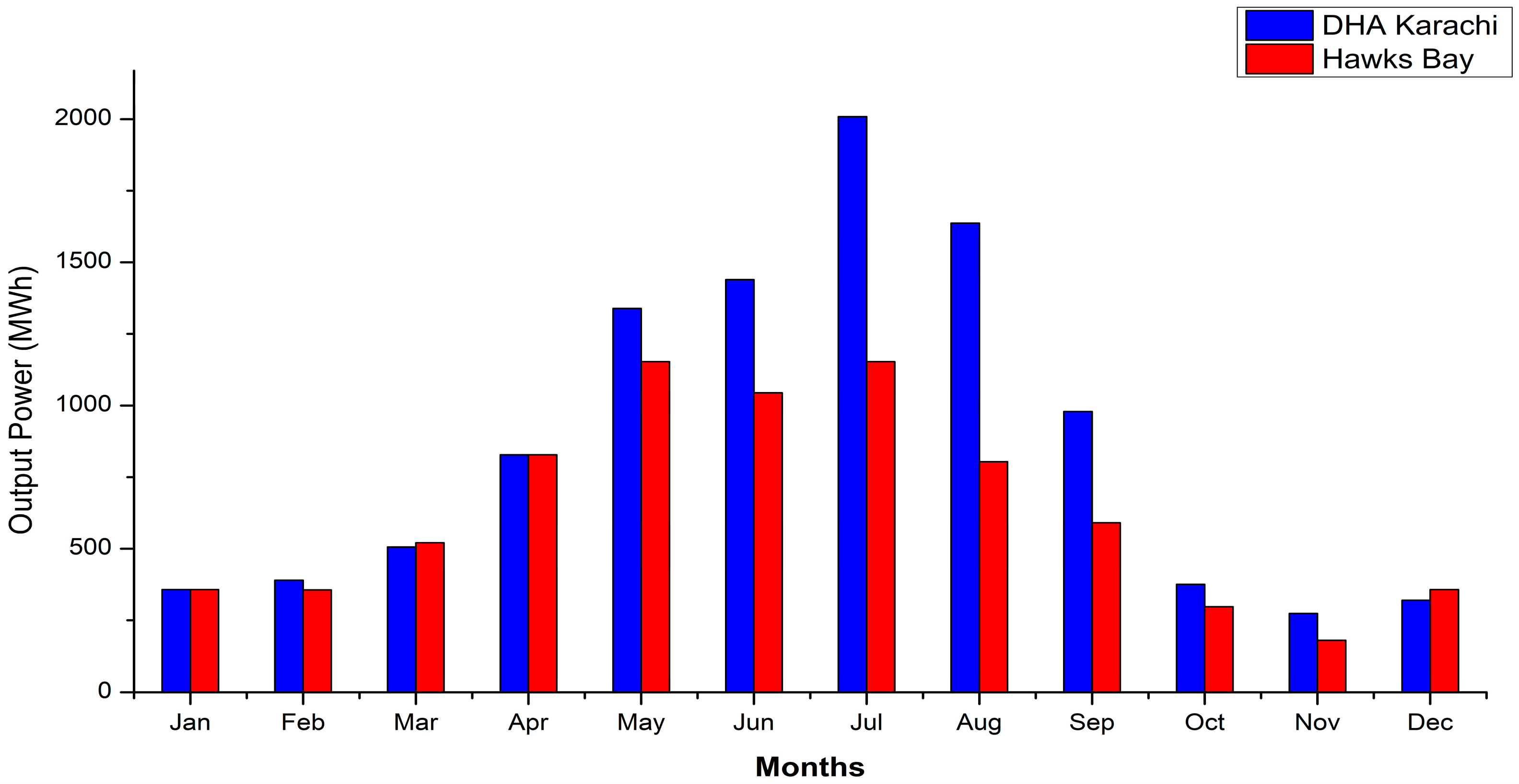



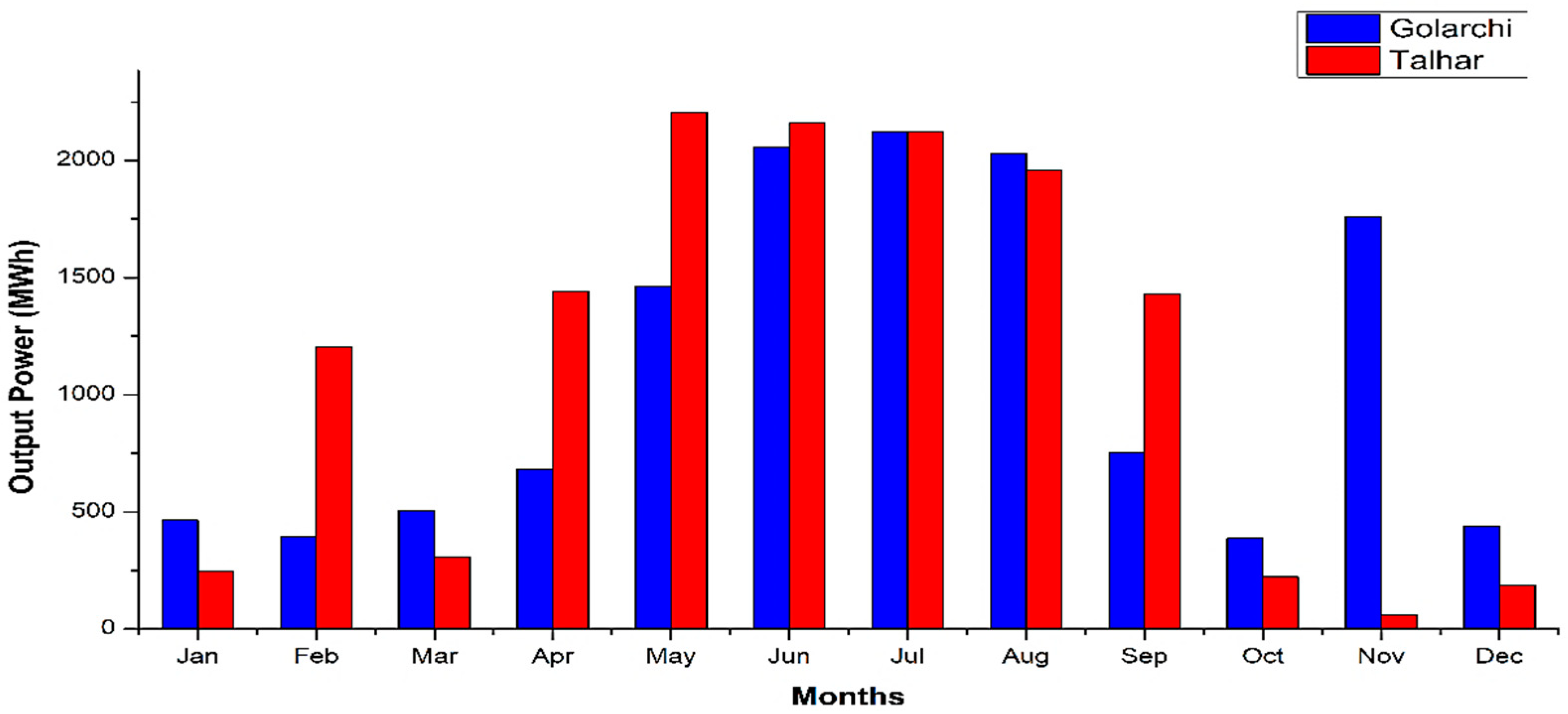
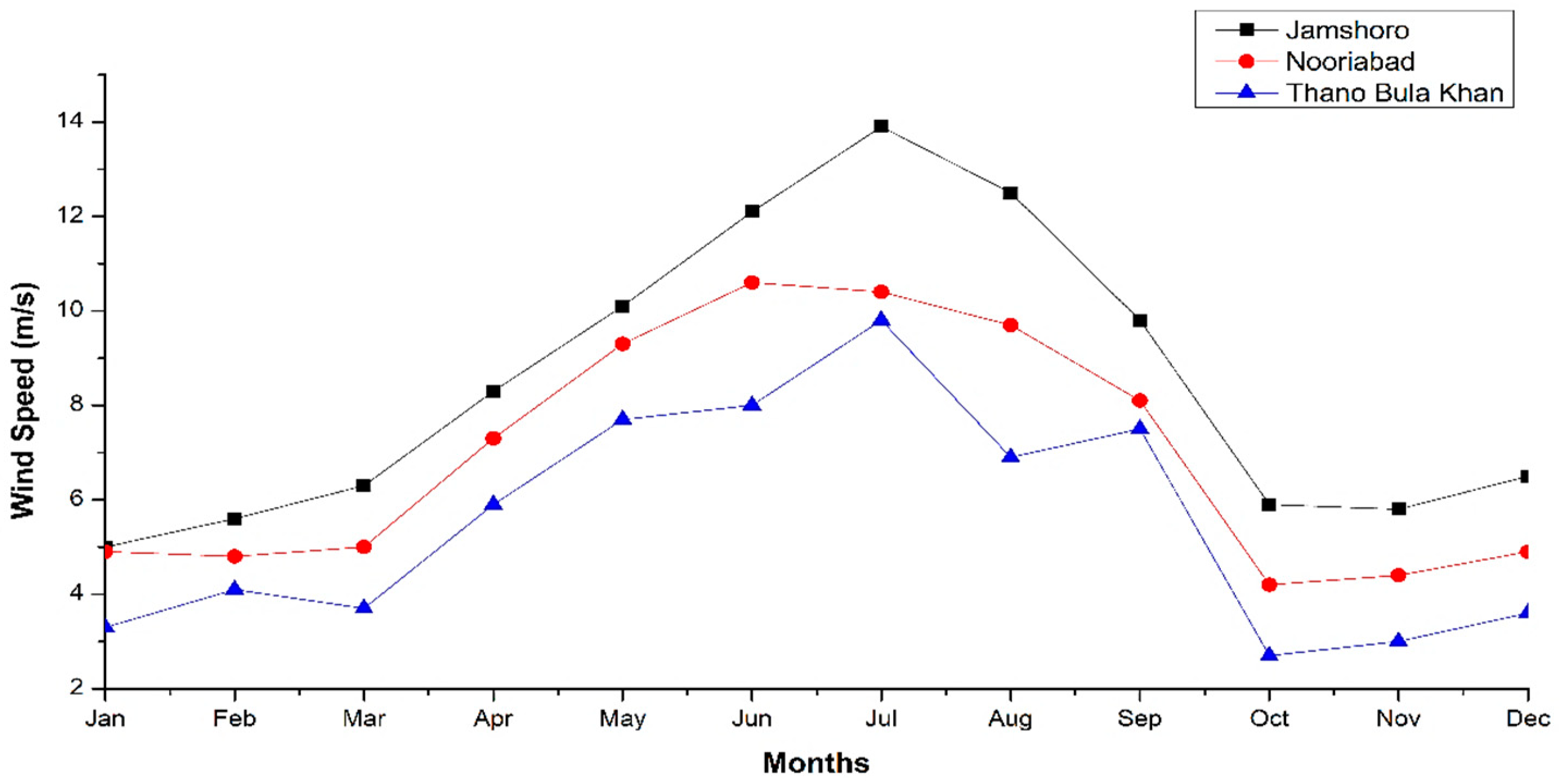
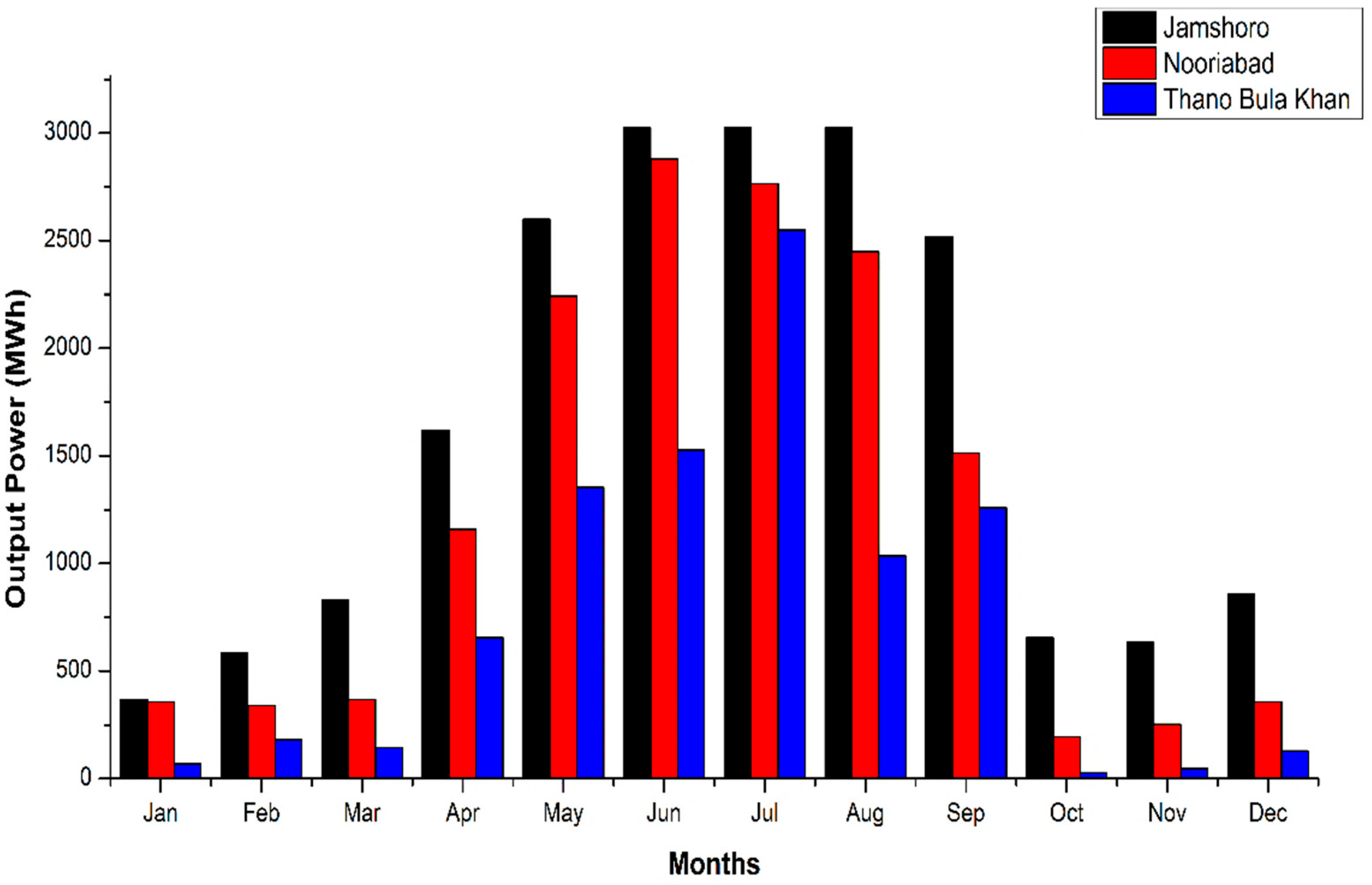


| Parameters | DC Generators | Synchronous Generator | Asynchronous Generator | ||||
|---|---|---|---|---|---|---|---|
| Electromagnetic | PM | Reluctance | HTS | FISG | DFIG | ||
| Efficiency | Low | High | Highest | Moderate | Highest | Low | High |
| Outlay | Low | Moderate | Highest | Moderate | Highest | Low | Moderate |
| Dependability | Fair | High | Highest | Highest | Moderate | Moderate | High |
| Controllability | Inferior | Better | Better | Better | Best | Better | Better |
| Speed | Constant | Variable | Variable | Variable | Variable | Variable | Variable |
| Fault response | Lower | Moderate | Moderate | Moderate | High | Lower | Moderate |
| Converter size | Full | Full | Full | Full | Full | Not Required | 20–30% |
| Grid-Provision Ability | Lower | Moderate | Highest | Moderate | High | Lower | High |
| Mass saving | Lower | Moderate | Highest | Lower | Highest | Lower | Moderate |
| Power supply | Direct Grid Connection | Total | Total | Total | Total | Direct Grid Connection | Partial |
| Maximum Power | Low | Moderate | High | Low | Moderate | Low | High |
| Active–reactive power | No | Separate | Separate | Separate | Separate | Dependent | Separate |
| Voltage fluctuation | High | Low | Low | Moderate | Very Low | High | Low |
| Application | Domestic/Small-Scale wind application | Small–Medium Wind Application | Small–Medium Wind Application | Developing Phase | Developing Phase | Small-Scale wind applications | Medium–Large Wind Application |
| Name | Manufacturer | Country | Rotor Dia. (m) | Swift Area (m2) | Rated Power (MW) | Generator Types | On/Offshore | Status |
|---|---|---|---|---|---|---|---|---|
| Acciona | Acciona Energy S.A. | Spain | 70–148 | 3848–17,203 | 1.5–3.3 | Asyn | Yes/No | Active |
| Adwen | Adwen Offshore, S. L | Spain | 116–180 | 10,568–25,447 | 5.0–8.0 | Syn, Asyn | Yes/Yes | Active |
| AMSC | American Superconductor | America | 82–190 | 5281–28,353 | 1.65- 10.0 | Syn, Asyn | Yes/Yes | Active |
| Bard | BARD Holding | Germany | 122 | 11,690 | 5.28–6.5 | Syn, Asyn | Yes/Yes | Active |
| Dongfang | Dongfang Electric Co. | China | 70- 185 | 3848–26,880 | 1.5–10.0 | Syn | Yes/Yes | Active |
| Envision | Envision Energy | China | 70.6–161 | 3915–20,358 | 1.5–5.0 | Asyn | Yes/No | Active |
| Fuhrlander | Fuhrländer AG | Germany | 12.8–132 | 130–13,685 | 0.02–3.0 | Syn, Asyn | Yes/No | Inactive |
| GE | GE Renewable Energy | America | 46–220 | 1662–38,000 | 0.6–14.0 | Syn, Asyn | Yes/Yes | Active |
| HITACHI | Hitachi, Ltd. | Japan | 80–136 | 4978–14,540 | 2.0–5.2 | Syn, Asyn | Yes/Yes | Active |
| MingYang | MingYang Smart Energy | China | 77.1–242 | 4369–46,000 | 1.5–16.0 | Syn, Asyn | Yes/Yes | Active |
| Mitsubishi | Mitsubishi Power, Ltd. | Japan | 25–167 | 490.9–21,900 | 0.25–7.0 | Syn, Asyn | Yes/Yes | Active |
| Nordex | Nordex SE | Germany | 17–163 | 227–20,867 | 0.6–5.0 | Syn, Asyn | Yes/Yes | Active |
| REpower | REpower Systems | Germany | 48.4–152 | 1840–18,146 | 0.6–6.15 | Syn, Asyn | Yes/Yes | Inactive |
| Siemens | Siemens Wind Power A/S | Denmark | 62–154 | 3020–18,600 | 1.3–7.0 | Syn, Asyn | Yes/Yes | Inactive |
| Siemens Gamesa | Siemens Energy AG | Spain | 114–222 | 10,207–39,000 | 2.1–14.0 | Syn, Asyn | Yes/Yes | Active |
| Unison | Unison Co., Ltd. | Korea | 50–146.3 | 1963–16,812 | 0.75–4.2 | Syn | Yes/No | Active |
| Vestas | Vestas Wind Systems | Denmark | 10–236 | 78.5–43,742 | 0.2–15.0 | Syn, Asyn | Yes/Yes | Active |
| W2E | Wind to Energy GmbH | Germany | 116–215 | 10,568–36,305 | 2.0–9.0 | Syn, Asyn | Yes/Yes | Active |
| Windtec | American Superconductor | America | 80–190 | - | 2.0–10.0 | Syn, Asyn | Yes/Yes | Active |
| Resource Potential | Wind Speed at 50 m (m/s) | Wind Power Class | Covered Area (km/s) | Output Power (W/m2) | Area Percentage | Total Output Power (GW) |
|---|---|---|---|---|---|---|
| Good | 6.9–7.4 | 4 | 18,106 | 400–500 | 2.05 | 90.53 |
| Excellent | 7.4–7.8 | 5 | 5218 | 500–600 | 0.59 | 26.09 |
| Outstanding | 7.8–8.6 | 6 | 2495 | 600–800 | 0.28 | 12.48 |
| Superb | >8.6 | 7 | 543 | >800 | 0.06 | 2.72 |
| Total | 26,362 | 2.98 | 131.82 |
| Wind Class | Description | Wind Speed (m/s) | Power Density (W/s2) |
|---|---|---|---|
| 1 | Poor | 0–5.4 | 0–200 |
| 2 | Marginal | 5.4–6.2 | 200–300 |
| 3 | Moderate | 6.2–6.9 | 300–400 |
| 4 | Good | 6.9–7.4 | 400–500 |
| 5 | Excellent | 7.4–7.8 | 500–600 |
| 6 | Outstanding | 7.8–8.6 | 600–800 |
| 7 | Superb | Greater than 8.6 | Greater than 800 |
| Project | Company | Location | District | (MW) | Status | Cost ($) | Completed |
|---|---|---|---|---|---|---|---|
| Jhimpir Wind Energy Project | Burj Capital | Jhimpir | Thatta | 49.7 | Active | 134 million | 2013 |
| Jhimpir Wind Power Plant | Morlu Enerji | Jhimpir | Thatta | 56.4 | Active | 143 million | 2013 |
| FFC Energy Ltd. | Fauji Fertilizer Company | Jhimpir | Thatta | 49.5 | Active | 134 million | 2013 |
| Three Gorges First Wind Farm | China Three Gorges Corporation | Jhimpir | Thatta | 49.5 | Active | 125 million | 2014 |
| Foundation Wind Energy–II | Fauji Foundation | Gharo | Thatta | 50 | Active | 127 million | 2014 |
| Foundation Wind Energy–I | Fauji Foundation | Gharo | Thatta | 50 | Active | 128 million | 2015 |
| Sapphire Wind Power | Sapphire Group | Gharo | Thatta | 52.8 | Active | 127.7 million | 2015 |
| Yunus Energy | Lucky Cement Limited | Jhimpir | Thatta | 50 | Active | 110.2 million | 2016 |
| Metro Wind Power | Infraco Asia Development Pvt Ltd. | Jhimpir | Thatta | 50 | Active | 136 million | 2016 |
| Tenaga Generai Ltd. | Tenaga Generasi Limited | Gharo | Thatta | 49.5 | Active | 117 million | 2016 |
| Gul Ahmed Wind Power | Gul Ahmed Energy Limited | Jhimpir | Thatta | 50 | Active | 131 million | 2016 |
| Master Wind Energy | Master Group of Industries | Jhimpir | Thatta | 52.8 | Active | 125 million | 2016 |
| Tapal Wind Energy | Tapal Group and Akhtar Group | Jhimpir | Thatta | 30 | Active | - | 2016 |
| Hydro-China Dawood Power | Hydrochina Corporation | Gharo | Thatta | 49.5 | Active | 115 million | 2017 |
| Sachal Energy Wind Farm | Arif Habib Group | Jhimpir | Thatta | 49.5 | Active | 134 million | 2017 |
| United Energy Pakistan | United Energy Group | Jhimpir | Thatta | 99 | Active | 250 million | 2017 |
| Hawa Energy Ltd. | Hawa Energy and JS Group | Jhimpir | Thatta | 49.6 | Active | 130.2 million | 2018 |
| Artistic Energy Pvt Ltd. | General Electric and Artistic Milliners | Jhimpir | Thatta | 49.5 | Active | 120 million | 2018 |
| Three Gorges Second Wind Farm | China Three Gorges Corporation | Jhimpir | Thatta | 49.6 | Active | 113.1 million | 2018 |
| Three Gorges Third Wind Farm | China Three Gorges Corporation | Jhimpir | Thatta | 49.6 | Active | 113 million | 2018 |
| Tricon Boston Corporation | General Electric and Tricon Boston | Jhimpir | Thatta | 148.8 | Active | 342 million | 2018 |
| Zephyr Power Ltd. | CDC Group PLC | Gharo | Thatta | 50 | Active | 103.3 million | 2019 |
| Zone | District | Region | 30 m | 50 m | Class (30 m) | Class (50 m) | ||||
|---|---|---|---|---|---|---|---|---|---|---|
| Low | Average | High | Low | Average | High | |||||
| 1 | Karachi | DHA Karachi | 2.9 | 5.0 | 7.4 | 3.6 | 5.9 | 9.0 | 1 | 2 |
| Hawks Bay | 2.8 | 5.1 | 6.8 | 3.2 | 5.4 | 7.1 | 1 | 2 | ||
| 2 | Thatta | Chuhar Jamali | 2.9 | 4.6 | 7.4 | 3.9 | 5.8 | 8.0 | 1 | 2 |
| Gharo | 3.0 | 5.9 | 9.1 | 3.8 | 6.6 | 9.4 | 2 | 3 | ||
| Jati | 3.5 | 5.4 | 8.5 | 4.4 | 6.4 | 9.1 | 2 | 3 | ||
| Keti Bandar | 4.1 | 6.1 | 9.1 | 4.4 | 7.0 | 10.2 | 2 | 4 | ||
| Mirpur sakro | 2.8 | 5.2 | 9.2 | 3.6 | 6.4 | 10.7 | 1 | 3 | ||
| Sajawal | 3.0 | 5.0 | 7.7 | 4.2 | 6.6 | 9.7 | 1 | 3 | ||
| Shah Bandar | 3.8 | 5.8 | 8.9 | 4.5 | 6.5 | 9.6 | 2 | 3 | ||
| 3 | Badin | Golarchi | 3.2 | 5.1 | 7.5 | 4.3 | 6.7 | 9.4 | 1 | 3 |
| Talhar | 2.0 | 4.6 | 7.3 | 2.7 | 6.3 | 10.3 | 1 | 3 | ||
| 4 | Jamshoro | Jamshoro | 3.7 | 6.9 | 11.6 | 5.0 | 8.5 | 13.9 | 4 | 6 |
| Nooriabad | 3.5 | 6.4 | 9.7 | 4.2 | 7.0 | 10.6 | 3 | 4 | ||
| Thano Bula Khan | 2.1 | 4.7 | 8.7 | 2.7 | 5.5 | 9.8 | 1 | 2 | ||
Publisher’s Note: MDPI stays neutral with regard to jurisdictional claims in published maps and institutional affiliations. |
© 2022 by the authors. Licensee MDPI, Basel, Switzerland. This article is an open access article distributed under the terms and conditions of the Creative Commons Attribution (CC BY) license (https://creativecommons.org/licenses/by/4.0/).
Share and Cite
Asghar, R.; Ullah, Z.; Azeem, B.; Aslam, S.; Hashmi, M.H.; Rasool, E.; Shaker, B.; Anwar, M.J.; Mustafa, K. Wind Energy Potential in Pakistan: A Feasibility Study in Sindh Province. Energies 2022, 15, 8333. https://doi.org/10.3390/en15228333
Asghar R, Ullah Z, Azeem B, Aslam S, Hashmi MH, Rasool E, Shaker B, Anwar MJ, Mustafa K. Wind Energy Potential in Pakistan: A Feasibility Study in Sindh Province. Energies. 2022; 15(22):8333. https://doi.org/10.3390/en15228333
Chicago/Turabian StyleAsghar, Rafiq, Zahid Ullah, Babar Azeem, Sheraz Aslam, Muhammad Harris Hashmi, Ehtsham Rasool, Bilawal Shaker, Muhammad Junaid Anwar, and Kainat Mustafa. 2022. "Wind Energy Potential in Pakistan: A Feasibility Study in Sindh Province" Energies 15, no. 22: 8333. https://doi.org/10.3390/en15228333
APA StyleAsghar, R., Ullah, Z., Azeem, B., Aslam, S., Hashmi, M. H., Rasool, E., Shaker, B., Anwar, M. J., & Mustafa, K. (2022). Wind Energy Potential in Pakistan: A Feasibility Study in Sindh Province. Energies, 15(22), 8333. https://doi.org/10.3390/en15228333














